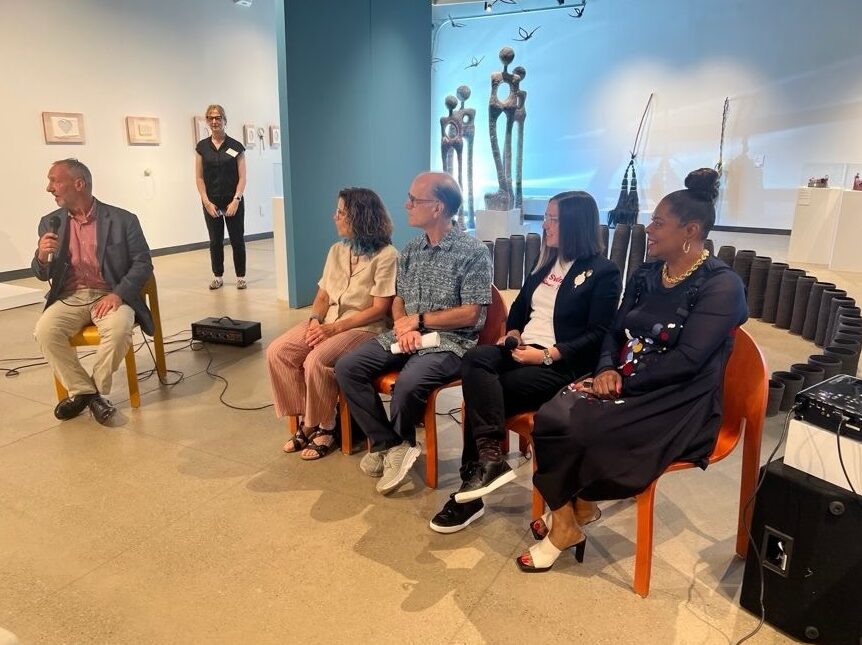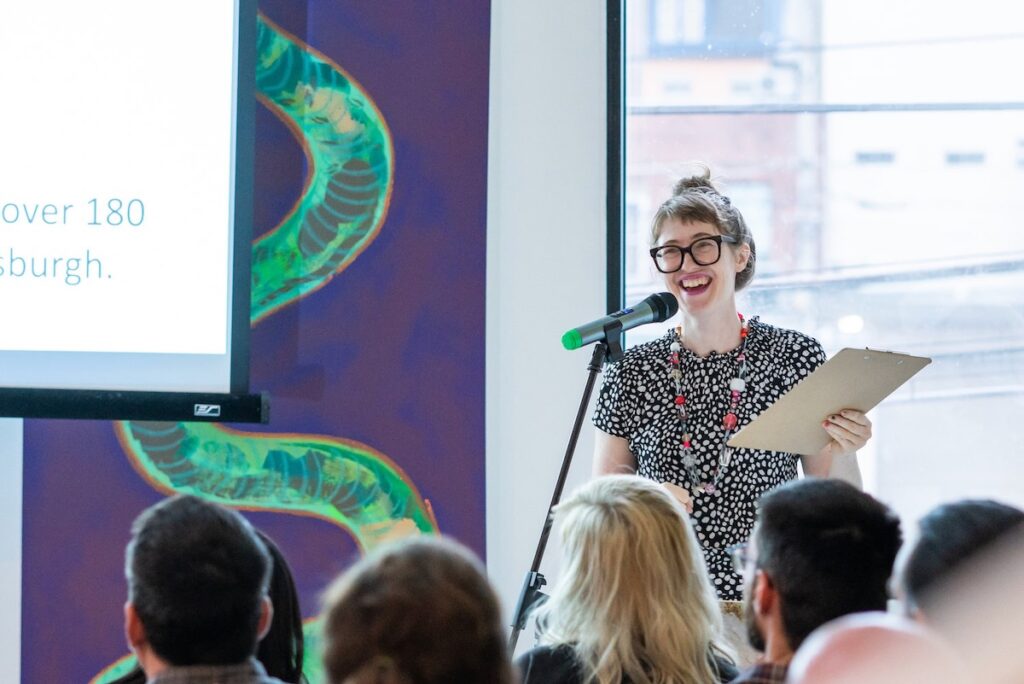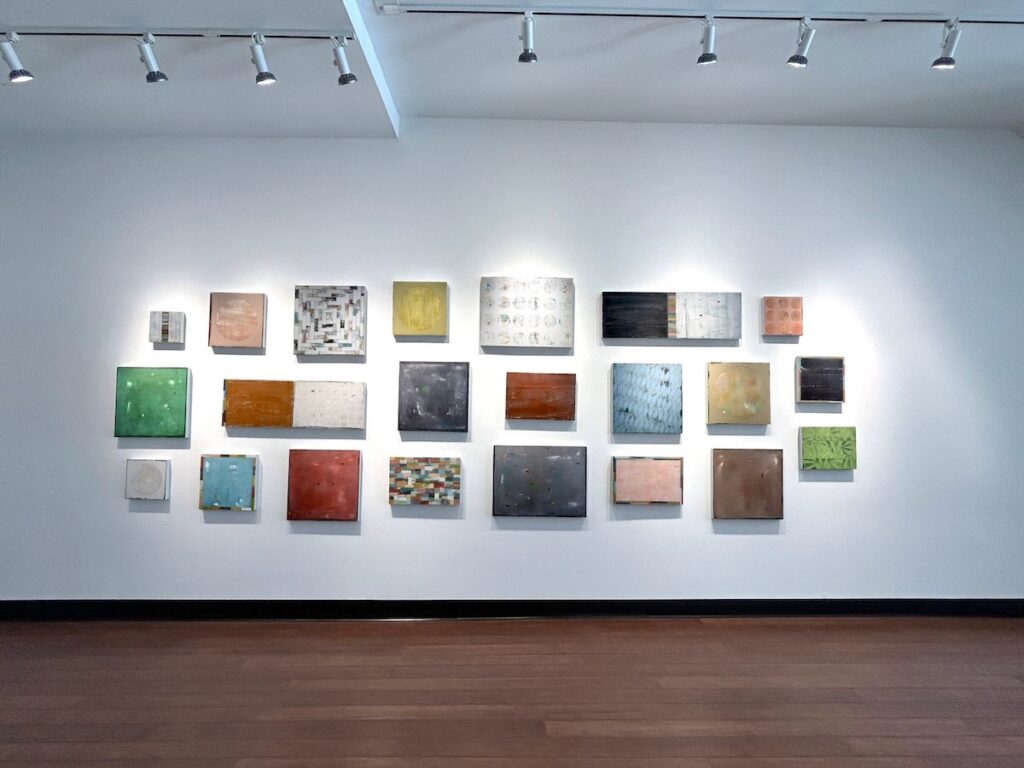A magazine ad from 1996 imagines a future where a burger and fries cost $16, a vacation $12,500 and a car $65,000. The ad proclaims “No problem. You’ll eat in. You won’t drive. And you won’t go anywhere.” It now appears we live in a version of that future. The average American’s purchasing power is lower than it used to be. So, in today’s world, what role can buying art have in our lives?
One argument for buying paintings is that unlike the car, burger, or vacation, you’ll have the painting for your whole life. But the main misconception around buying art is that you have to be a member of the ultra-rich to do it. Gallerist Jeffrey Jarzynka of ZYNKA Gallery remembers buying a $2,000 painting—Scott and Shelly at the Cup O’ Joe Coffeehouse by Benjamin Gersch—for the first time. “I thought I was going to die,” he said of how intimidating the purchase was. But now Jarzynka is one of the many professionals in Pittsburgh who help others develop their art collections.
So, You Want to Start Buying Art
Though buying art can seem intimidating, Pittsburgh has a range of more affordable options and a plethora of artists looking to sell. Let’s say you want something for your home that’s not an IKEA canvas and you want to support people in your local community. Where do you start?
Just Look as Much as You Can
Brian Lang, an independent art advisor who worked for many years as the curator for BNY Mellon, runs a “collecting bootcamp” series of lectures, studio visits, and workshops. “What I tell everybody is regardless of what level you plan to buy at, see as much as you can possibly see and read as much as you can possibly read. You want to go to galleries and museums, as well as artists’ studios,” Lang said.
Institutions like Contemporary Craft, where Lang has had many of his bootcamp lectures, make for a good starting point. “People often think ‘If I don’t buy a Jackson Pollock, then I’m not a collector,'” Lang said.

Jarzynka added that “Art can very much seem like a luxury item, but I don’t see it that way for myself. It’s not a need like water or shelter, but it enhances my living experience. That’s what I hope people get out of it.” For his buyers, he makes digital mockups of how the pieces will look on their walls at home so they can acquaint themselves with seeing it every day.
Find Out What You Like
Margaret Kross, curator of independent gallery Romance, has seen many different levels of collection across her career. She previously worked under Paula Cooper in New York, and chose to start her own space in Pittsburgh. Outside of the gallery, she advises collectors and would-be collectors on how to start buying art or streamline what they already have. “The more you learn, the more you’ll actually realize what you don’t know, but by being open to going down self-directed research holes yourself or by working with an advisor if you like a more collaborative and hand-held process, you can carve out specific areas of interest—that respond to things you care about in the world or that you connect with you on a personal, emotional level,” Kross said.
Jarzynka compared buying art to buying anything else. It’s a way to get to know yourself and your tastes. “Ask yourself ‘What do you react to? Do you like paintings, textiles, glass, bright colors? It’s so important for people to be out and experience it.”
A ”Crop Top” Art Market
Art consultant Casey Droege runs The Art Supply Co, which serves as an intermediary between artists and businesses looking to buy artwork. Droege said that “If a thriving arts scene is important to you, then I’d encourage you to buy art. If your budget is tight, that might mean buying a $5 postcard. But showing up and encouraging the people involved is a meaningful contribution. Adding some money to that mix is always a welcome bonus.”

Droege noted that the “collecting culture” in Pittsburgh, as she sees it, is a little bit like a crop top outfit. “On the bottom, we’ve got the pants. It’s an area that is ripe with small arts nonprofits, DIY artist spaces and cooperatives, artist-run projects, pop-ups, and some independent galleries,” she said. “On top, we’ve got the crop top. Museums, private/corporate collections, foundations, and universities.” This stymies local artists’ growth, she explained, and can keep collectors from feeling like they have a place to support local artists. Part of her goal with The Art Supply Co is to create a more active middle market. “Let’s get Pittsburgh a full-length t-shirt!” she said.
As an additional plus, buying artwork in Pittsburgh is supporting the economy during a time of overall downturn, Lang noted, given that it doesn’t just support the artist, but also the cultural workers make a living off of the art business. Droege agreed, saying that “Purchasing art is an opportunity to directly support an arts ecosystem including the artist who made the work. You’re supporting the space and the myriads of people involved in that process like framers, art handlers, and photographers.”
Buying Art Starts with Loving Art
Kross added that the work of art’s life doesn’t end when it goes into your collection. A level of care has to go into keeping and maintainng it. “Framing can be expensive, but it’s important,” she said. “Artists care a great deal about it and might even have recommended specifications. Framers are also extremely knowledgeable and can make recommendations within a budget you feel comfortable with.”
In the local market, Jarzynka sees a need for more growth in the “pants” side, too: younger buyers who might not see themselves as “collectors” but are just starting out. He encourages people to follow what really speaks to them. “A lot of my collection was built on traveling and wanting to take home something that wasn’t a traditional souvenir,” he said.

Collectors like Yvonne Cook, whom Lang featured in his bootcamp lecture series, also help the Pittsburgh art market develop by talking publicly about buying art. Cook frequently posts on social media about art she likes, showing people that “collectors” can also be everyday people in your community. She focuses on work by contemporary Black artists, and her openness about her collecting helps to move away from the image of the collector from an old, extravagantly wealthy white man. A collector starts as an art lover who falls in love with one particular piece.
Works at Every Price Point
“One misconception is that galleries are these incredibly lucrative, exclusive, luxury stores for expensive objects that might buy you clout and social capital,” Kross said. “Of course, this can be true, and art is a financial commitment. But it’s also one of patronage that keeps artists afloat and the places committed to showing their work.” She knows a collector who exclusively buys from benefit auctions, or people that only buy editions or flatfiles to start with. “There are very few exhibition slots in museums for the many amazing artists in the world! [Galleries] are just doing what we can to make it work in an enormous and insane labor of love, both to support artists and to participate in the complex dialogues of our time and the past.”
Lang agreed that people see the price of art and often don’t know what’s behind that. “Many people might go into a gallery and see things that are not within their budget and get discouraged,” he said. “But if you like a piece, ask the gallerist if there are other works available from earlier in the artist’s career, or an edition, or something smaller.” And if you really love a piece, it’s worth saving up for. “Art can add so much for our lives, and artists should be seen as national treasures. Period. They help us all see the world from a different point of view, and bring us together in our shared humanity,” Lang said.
Story by Emma Riva
Photo courtesy of ZYNKA Gallery
Subscribe to TABLE Magazine‘s print edition.
